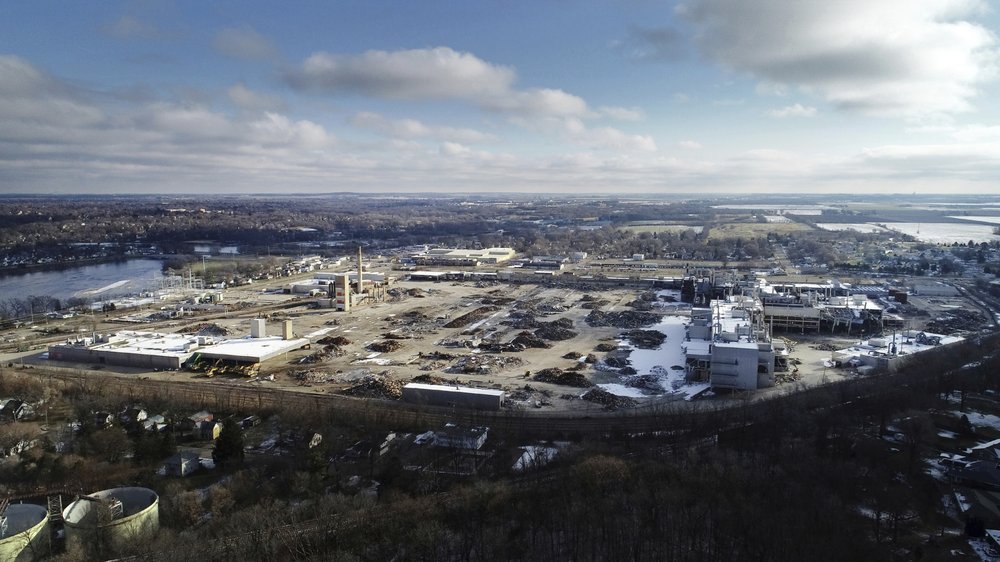Wisconsin
GM staff reflect on Janesville plant closing 10 years later

JANESVILLE, Wis. (AP) — At the General Motors assembly plant, Jeff Hanson horsed truck bodies onto vehicle frames — one every 56 seconds, hundreds in an eight-hour or 10-hour shift.
It was one of Hanson’s many jobs as a floating line worker, filling in wherever and whenever other co-workers were absent.
Co-workers called Hanson “Big Dog.” His arms were big and burly. They still are, even though Hanson’s factory days are long past, The Janesville Gazette reported. He took a buyout from GM in 2007, when a decade-long boom in SUV production began to sputter amid $4 gasoline and the early stages of the Great Recession.
About a year later, Dec. 23, 2008, GM ended production at the Janesville plant where Hanson and thousands of others once worked. It took almost seven years, but in October 2015, GM announced from contract negotiations with the United Auto Workers that the plant would shutter and be sold off. The 4.8 million-square-foot husk is now being demolished and the site cleared for redevelopment by a new owner.
Dec. 23, 2018, marked the 10-year anniversary of GM Janesville’s main assembly lines shutting down.
“Was I shocked? No.
“Was I disappointed? Yes,” Hanson recalled.
“You had a lot of friends, hard workers, good people who had to take jobs all over the country. It put strain on top of strain for so many people.”
Like windblown seeds, scores of lives once pegged to the GM plant have scattered. Hundreds of GM workers and dozens of supervisors pulled up roots in 2008 and left Janesville to work at other GM plants around the country, pursuing retirement and pensions they’d worked toward for years.
Some had no choice but to change jobs. Some who left Janesville have since returned in retirement to find time did not stand still and their hometown and neighborhoods changed.
Others will continue to commute to GM plants hours from Janesville until they can retire to a pension. Some still dream about the auto plant that’s now nearly half demolished, slated for industrial reuse by a developer.
The lives of former GM workers have not stopped. They’ve been altered — for worse, for better, forever.
On a December Sunday morning at Janesville Apostolic Ministries, a small church just a few blocks south of the GM plant site, Jeff Hanson spread his big laborer’s arms to reach out and grab a man in the congregation by his shirt.
In a firebrand moment with playful glee in his eyes, Hanson shook the man by the collar and shouted into his face, “Do you know what happened to me?”
One possible answer: Hanson is no longer an autoworker at GM, but he has found who he actually is.
Hanson is one of two pastors at Janesville Apostolic Ministries — a church Hanson said he started out of people’s houses eight years ago with four members, including his wife, Carmen. Hanson has honed the art of preaching and grown his congregation to about 40 members under the roof of a former Baptist church on South Jackson Street.
Recently, he began serving as a chaplain to Rock County sheriff’s deputies.
It’s a 40-hour work week, sometimes 60 hours, if Hanson counts home visits with members of his church. But from the preacher’s lectern, he feels as animated as when he was a younger man working at Delco Electronics in Oak Creek. He’d been there two decades before he transferred to the Isuzu line at Janesville’s GM plant in 1995.
As Hanson preached, he walked around the sanctuary giving fist bumps to parishioners with his broad hands in the middle of service. He’s as hands-on in ministry as he might have been with a truck body that needed to be moved to assembly.
Hanson’s favorite biblical verse is from Romans Chapter 12: “Do not conform to the pattern of this world, but be transformed by the renewing of your mind.”
Hanson said he was a certified minister during his last several years at GM, but few knew it. Hanson said he never worked up the courage to actually preach until a few years after GM shuttered. He felt like an invisible door had flown open.
“Manufacturing was just what I did. You couldn’t do much better without a college degree,” Hanson said. “What changed, I think, it could have been fear going away. You get older, you sometimes get bolder.”
A recent service at Hanson’s church included a talk by representatives from a nonprofit group that serves the needy. They showed the congregation statistics that peg the poverty rate in Rock County at 41 percent.
Hanson says he’s a “glass-half-full guy.” He wears a screen-printed shirt that reads: “If you can’t look on the bright side, I’ll sit with you in the dark.” Still, he’s lived through the death of his 37-year-old son from an opioid overdose and a daughter’s bout with cancer.
And Hanson acknowledged the past 10 years have strained others in Janesville, too.
“It’s a mixed bag. Retail has exploded on the northeast side of town. Down here, on the south side, near GM, some parts of town seem almost dead.
“You’re happy to see some jobs have come back, but down deep, you know none of them are going to pay you what you could have earned (at GM).
“But I try to look at the positive side. I don’t think you have a problem finding a job in Janesville now.”
For the first time in a decade, Pam McCullick is back home in her tidy ranch house on Janesville’s south side.
She’s catching up with life in Janesville after seven years away, half spent in Kansas City, Kansas, working at GM’s Fairfax Assembly stamping plant. In 2016, McCullick retired from GM after nearly four years working at a GM assembly plant four hours away in Fort Wayne, Indiana.
In 2008, when the Janesville plant was set to shutter, McCullick made the same move as hundreds of other Janesville GM workers. GM plants around the country needed workers, and McCullick had years left before she could collect the pension she’d worked toward since 1986.
But in 2008, McCullick was no longer 22, as she’d been when she started at GM. She was a single parent, and her son Dylan was a sophomore in high school at Oakhill Christian School in Janesville.
Dylan is grown now. He’s an engineer and a husband. But McCullick missed most of her son’s passage from boy to man.
Dylan stayed in Janesville; McCullick left to work out of state. First it was the Kansas City plant eight hours away. McCullick recalled looking for an apartment near the school Dylan would have attended in Kansas City.
That same day, she saw a police SWAT team chasing men through a busy commercial area of the city, their guns drawn. After that, she and Dylan talked and together decided he’d finish high school in Rock County.
“On top of everything else, it was culture shock,” McCullick said. “We broke down the best decision we could make at the time. Then, I broke down crying, over and over.”
McCullick and dozens of co-workers who relocated to keep their jobs found living arrangements together, splitting costs on apartments in Kansas City and later in Fort Wayne. The workers carpooled every weekend from Kansas City or Fort Wayne to Janesville.
For McCullick, commuting was the only way she could spend time with Dylan.
By McCullick’s estimates, the driving cost as much as $6,000 a year. Workers would leave at 7 a.m. after their last weekday shift, hit the road and drive eight hours from Kansas City to Janesville. They’d turn around on Sunday and drive back to start another work shift.
Dylan’s grandparents and a friend of McCullick’s stayed the night with Dylan during the week. McCullick said she learned how to troubleshoot over the phone, talking Dylan through everything from home maintenance to schoolwork to giving their elderly dog a daily insulin injection.
McCullick said she was lucky family and friends could help raise her son during her years on the road.
“It takes a village, and I was fortunate. My son became quite responsible,” McCullick said.
McCullick said the Janesville GM expatriates learned to discuss their lives openly during the long car rides between work and Janesville.
McCullick made a quilt from the scores of UAW T-shirts she collected during her years as a traveling autoworker. One shirt has a pair of ruby slippers. She has a box full of photos of the old Janesville plant, including photos taken the last day of operations.
It’s taken a few years for it to sink in that she’s retired from GM and that the back-and-forth trips are over. McCullick said she still wakes some days with a feeling she’s only home for a temporary plant shutdown.
Some Janesville GMers still work out of town. They’ve got years left before they can retire to a pension. Some who’ve commuted to out-of-state plants had parents, spouses and children die while they were gone, McCullick said.
By the time some of the workers retire and return, the Janesville plant might be completely gone. It’s on pace to be fully demolished and its 250-acre footprint cleared by Commercial Development Company, the new owners, sometime over the next year.
Commercial Development intends to groom the GM site for industrial redevelopment that would leverage the site’s rail infrastructure.
Some people from the Janesville plant had a chance to finish their careers elsewhere, McCullick said. Not everyone who worked at the plant or local suppliers was so fortunate.
“We really are the lucky ones,” McCullick said.
Sometimes in his dreams at night, Milton resident Dan Roehl finds himself on an assembly line at GM. In the dreams, the assembly line’s always broken down or backed up, and there’s nothing he can do to fix it.
“Nine out of 10 people will tell you that. The one that tells you that they didn’t have that dream is lying. At some time, we all had that fear,” Roehl said.
Roehl retired from GM a few years ago. Like McCullick, Roehl spent years traveling back and forth from Fort Wayne.
He grew up in Janesville “in the shadows of GM,” he said. His dad, an uncle and other relatives all worked at the plant. They were crew-cut line workers and supervisors who scrimped, Roehl said, always saving for the next rainy day or labor strike.
Roehl did two stints in Fort Wayne, one between 1986 and 1992 and another after the Janesville plant ended production in 2008, until he retired in 2015.
Roehl has a salesman’s knack for conversation, and his eyes are sharp and direct. He doesn’t mince words about how and when the Janesville plant’s fortune began to sour. It started two decades before the plant’s 2008 mothballing, he said.
It was after 1984, when pickup truck production along with 1,800 jobs were slated to move out of Janesville to a newly tooled plant in Fort Wayne. The Janesville plant was assigned to the Buick-Oldsmobile-Cadillac group under restructuring. The mid-1980s were a dark period, Roehl recalled, when Janesville and many other GM plants came under a threat of closure as GM began massively restructuring and replacing obsolete plants around the U.S.
That was when Roehl, a longtime UAW safety rep, took his first transfer to Fort Wayne.
The Janesville plant did not cease in the 1980s, but even after the plant was reassigned in the 1990s to produce trucks and SUVs, and even as GM and the plant rode an economic boom that lasted years, Roehl couldn’t shake a notion that Janesville’s days as a GM town were numbered.
All Roehl’s children are grown, but when they were growing up, Roehl said, he gradually stopped believing his kids would inherit a job and a life at the GM plant.
“I felt like I’d be the last generation to retire. The end of a legacy,” Roehl said. “For me, after ’86, the reality was if they can look at closing Janesville, they can close anywhere, anytime.”
Roehl’s now working on a new legacy. In his retirement, he sells seed systems designed to improve hunting land. A lifelong outdoorsman and deer hunter, Roehl finds solace and enjoyment in working as a wildlife and habitat management consultant.
He’s worked with landowners throughout the Midwest, helping clients cultivate some 1,000 acres of prairie grasses and replacement cover that will support wildlife.
It’s given Roehl a sense of purpose that he said ranks with helping resolve safety and ergonomics issues at GM plants as a union rep.
“There’s nothing more exciting than when you see a young kid, when they plant something, a sunflower. They see it grow. They say, ‘I did that,’” Roehl said.
Roehl’s friend, former UAW local president, former GM plant worker and former state Assembly Speaker Mike Sheridan, took an opposite view on the GM plant’s prospects.
As an Assembly representative, Sheridan said he worked with the union and plant management at Janesville GM to try to lure GM into reactivating the defunct plant. For a while, he even held out hope that an industrial park on Janesville’s south side might be a location where GM eventually could build a new plant.
“I was the last guy to believe they weren’t coming back,” Sheridan said. “I always said, ‘I’m not giving up trying to get something until I see a bulldozer.’ I know I got criticized a lot for saying those things. Well, the bulldozers came. I came to acceptance.”
Sheridan, who was a Democratic member of the Assembly for six years, lost his seat in 2011, four years before GM and the UAW ultimately agreed in contract negotiations to remove the Janesville plant from standby status and mark it for permanent closure and sale.
For the last year, Sheridan has immersed himself in new work that has nothing to do with unions, auto work or politics. He’s now a volunteer for One2One Recovery Coaches. He’s part of a team of four trained counselors who work through Rock Valley Community Programs.
With One2One, Sheridan is on call day and night to visit local hospital emergency rooms where patients are in initial recovery from drug overdoses — mostly from heroin and other opioids. His group believes the first awakening after an overdose is a crucial time to offer support and counseling.
“We try and catch them and meet with them while they are still coming out of their overdoses. We want to help find a path out of the hell they’re in,” Sheridan said.
Sheridan said he had troubles with alcohol earlier in life. He’s been sober 25 years. He gave a simple reason for taking a new job path.
“I found out at age 60 what I wanted to be when I grew up,” he said.
Sheridan doesn’t accept comparisons of Janesville to auto cities in Michigan that hollowed out in the 1980s and 1990s after GM plant closures.
“The Flint (,Mich.,) or Detroit statements that the bottom falls out and everything goes to hell and stays that way, I think we’ve proved that’s not happened here,” Sheridan said.
Dan Roehl agrees. He was gone from the Janesville area enough years that when he returned he got lost on the Highway 26 bypass in Milton. He ended up in Whitewater and had to call his son for directions. Maybe that’s hyperbole, but Roehl said he’s seen evidence in the last few years that positive change has taken root in Janesville.
Even during GM’s boom days, Roehl said, few might have pictured Janesville’s downtown being home to microbreweries or professional bicycle races.
“I almost see a mini-revolution, revitalization. There’s good things going on in Janesville. I believe that,” Roehl said. “Will it ever be like it was in Janesville? I don’t know that we ever want to go back there. I don’t think you ever want to get so reliant on one industry that everything is based around that. I lived through that.
“I think diversification of industry and manufacturing of jobs is a good thing. Granted, there has been a loss of wages in jobs, that kind of stuff. A $20-an-hour wage is pretty much what it takes now. There’s no good answer on that.”
Sue Ludwig, former process control manager at Janesville GM, was among the first women to hold a supervisory position at the plant. She helped make sure the plant’s byzantine maze of lines ran smoothly.
Like many hourly workers, Ludwig during the 2007-08 fallout in Janesville chose to relocate to keep her job. She kept an apartment near a GM plant in Orion, Michigan, for two years. That plant hit a shutdown for retooling, and she retired but later went back to Fort Wayne as contract supervisor.
Ludwig said she’s wistful about the Janesville plant’s closure, even 10 years later. She can’t drive by the plant. Seeing weeds in the parking lot makes her cry. She can’t look as she passes the plant’s front office facade that now stands like a Hollywood set in front of rubble, twisted metal and emptiness.
Ludwig said she learned the ropes from men twice her age. In her early years at the plant, some of the men still cat-called women.
Ludwig said she respected the plant’s hourly workers with a depth she has trouble describing.
“Half of them were my dad’s age. I had to tell them to do something, I’d almost cry. It made me a manager. I listened to the people,” Ludwig said. “I’m as grateful to GM as I have been with anything in my life.”
Tears welled up in Ludwig’s eyes when she recalled the hard work, the huge employee potlucks that would line tables and the thousands of people she knew by name.
She even misses the ridiculous nicknames of people at the plant: Skimmer, Scooter, Psycho, Stewie.
“Everybody had nicknames, honey,” Ludwig said.
In her retirement, Ludwig visits friends from the plant and makes decorative mosaics. They’re made of broken glass Ludwig reassembles as something new.
Some of the mosaics Ludwig had made are in the backyard at her home off Newville Road. She lives north of Janesville, atop what she calls the highest hill in Rock County. On clear days, Ludwig can look out her window and see the tall, bone-colored smokestack at the GM plant seven miles away.
“That was our shining star down in the valley, GM was,” Ludwig said.
Ten years after the factory’s star winked out, the smokestack is still standing.
This story has been edited from an earlier version to reflect the correct name of the high school that Dylan McCullick attended.






